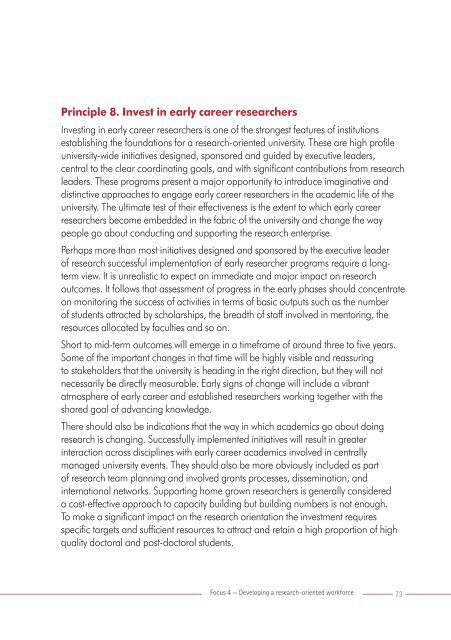handbook-executive-leadership-of-research-development-pdf-v10
handbook-executive-leadership-of-research-development-pdf-v10
handbook-executive-leadership-of-research-development-pdf-v10
You also want an ePaper? Increase the reach of your titles
YUMPU automatically turns print PDFs into web optimized ePapers that Google loves.
Principle 8. Invest in early career <strong>research</strong>ersInvesting in early career <strong>research</strong>ers is one <strong>of</strong> the strongest features <strong>of</strong> institutionsestablishing the foundations for a <strong>research</strong>-oriented university. These are high pr<strong>of</strong>ileuniversity-wide initiatives designed, sponsored and guided by <strong>executive</strong> leaders,central to the clear coordinating goals, and with significant contributions from <strong>research</strong>leaders. These programs present a major opportunity to introduce imaginative anddistinctive approaches to engage early career <strong>research</strong>ers in the academic life <strong>of</strong> theuniversity. The ultimate test <strong>of</strong> their effectiveness is the extent to which early career<strong>research</strong>ers become embedded in the fabric <strong>of</strong> the university and change the waypeople go about conducting and supporting the <strong>research</strong> enterprise.Perhaps more than most initiatives designed and sponsored by the <strong>executive</strong> leader<strong>of</strong> <strong>research</strong> successful implementation <strong>of</strong> early <strong>research</strong>er programs require a longtermview. It is unrealistic to expect an immediate and major impact on <strong>research</strong>outcomes. It follows that assessment <strong>of</strong> progress in the early phases should concentrateon monitoring the success <strong>of</strong> activities in terms <strong>of</strong> basic outputs such as the number<strong>of</strong> students attracted by scholarships, the breadth <strong>of</strong> staff involved in mentoring, theresources allocated by faculties and so on.Short to mid-term outcomes will emerge in a timeframe <strong>of</strong> around three to five years.Some <strong>of</strong> the important changes in that time will be highly visible and reassuringto stakeholders that the university is heading in the right direction, but they will notnecessarily be directly measurable. Early signs <strong>of</strong> change will include a vibrantatmosphere <strong>of</strong> early career and established <strong>research</strong>ers working together with theshared goal <strong>of</strong> advancing knowledge.There should also be indications that the way in which academics go about doing<strong>research</strong> is changing. Successfully implemented initiatives will result in greaterinteraction across disciplines with early career academics involved in centrallymanaged university events. They should also be more obviously included as part<strong>of</strong> <strong>research</strong> team planning and involved grants processes, dissemination, andinternational networks. Supporting home grown <strong>research</strong>ers is generally considereda cost-effective approach to capacity building but building numbers is not enough.To make a significant impact on the <strong>research</strong> orientation the investment requiresspecific targets and sufficient resources to attract and retain a high proportion <strong>of</strong> highquality doctoral and post-doctoral students.Focus 4 — Developing a <strong>research</strong>-oriented workforce73



